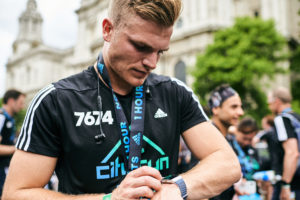The moment we enter a race, the likelihood is we’ll have a target in mind. It might be a conservative one or you might be looking to put your personal best out of sight, but it will be a target nonetheless. For anyone running this weekend’s adidas City Run in Shoreditch (www.adidascityruns.com), having a target – no matter what it is – will help fuel your progress around the nation’s capital.
 But what can we do on race day to make sure that our targets are achievable? Getting to the start on time and knowing the course are almost a given, but how many of us actually get race-ready by doing a proper warm up so that we can literally hit the ground running? Very few, I would imagine. And yet a dynamic warm up – like the one featured on the new Fitbit Ionic: adidas edition – can help get your body and muscles warm and ready to run.
But what can we do on race day to make sure that our targets are achievable? Getting to the start on time and knowing the course are almost a given, but how many of us actually get race-ready by doing a proper warm up so that we can literally hit the ground running? Very few, I would imagine. And yet a dynamic warm up – like the one featured on the new Fitbit Ionic: adidas edition – can help get your body and muscles warm and ready to run.
Dynamic stretching improves mobility and uses controlled movements to mimic the specific motions of your sport. For runners, dynamic stretching thus improves mobility of areas such as the hips, ankles, and knees while also warming up the muscles for the repetitive motion of running. The Fitbit Ionic: adidas edition features a five minute Dynamic Warm Up, which promises to increase your core temperature to get ready for a workout and a five minute Run Activation session that focuses on hip, core, and shoulder stability. These should help get your body ready for the demands of racing – and ensure that hit your goal.
The other key element in racing is pacing your run. Playing around with pace in training is great fun and if you’re not aiming for particular times or distances, there’s no need to worry too much about how fast you’re running at any given moment. However, as soon as you have a race target in mind – even if that target is to complete a 10K without walking – then you need to start thinking about pacing.
In a nutshell, there are two mistakes you can make in pacing: setting off too fast, or setting off too slow. The former is what catches most of us out. The obvious pacing mistake is going off too fast. Everybody’s done it. Generally speaking, it’s better to go off slower and build up.
This isn’t a mistake that’s confined to racing newbies, either – in fact, more experienced and competitive runners are perhaps at even greater risk of jumping the gun. Getting carried away by the atmosphere and the crowds in big races can make it difficult to avoid setting off too fast, while at quieter races it can be difficult to stick to your planned speed if you quickly find yourself running alone and feel the urge to ‘catch up’ with faster runners in the field. It’s essential to stick to your pre-race plan though and there’s no better way than using a Fitbit Ionic: adidas edition to make sure you’re running at the right pace for you.
In shorter races you’ll usually become aware that you’ve gone wrong sooner – the effects are less dramatic than a marathon as you’re unlikely to come to a complete standstill. However, whatever distance you’re running, it’s important to work out your strategy before you race and practise it in training.
Some people are probably naturally good at pacing but it’s definitely something you can learn. If you live your life intensely you might have a tendency to go off too fast, but it is possible to get better at pacing yourself over time.
However, if you’re not quite ready to rely on your internal body clock and its ability to pace you round the 10K, then it pays to use a device with GPS like the Fitbit Ionic: adidas edition. Hopefully you’ll have already been training with your Fitbit and will be used to its pacing capabilities. On race day, the important thing is to know how your goal finish time splits down in to either kilometre or mile splits: for example if you want to run a 50 minute 10K, then you’ll need to run around 8 minutes per mile or 5 minutes per kilometre.
You can track your entire race progress on your Fitbit, clicking the miles off as you run. The most effective way to pace your race is to run evenly, not to get carried away over the first third of the race and to finish strongly. This can only be achieved if you pace your race to perfection: having a Fitbit Ionic: adidas edition on your wrist is like having your own personal pacemaker. And who wouldn’t want that!
- The Fitbit Ionic: adidas edition smartwatch is designed to provide a unique coaching experience for runners and athletes of all levels who want to improve their performance. In addition to all the advanced health and fitness features of Fitbit Ionic, the adidas edition includes exclusive features such as the adidas Train app – six on-screen workouts and step-by-step coaching developed by adidas to help improve your form, power, and speed – a stylish and breathable sport band and unique adidas-designed clock face – all with up to five days of battery life.
For challenges, running tips, competitions and more about the Fitbit Ionic: adidas edition go to www.fitbitrun.co.uk. If you’re looking for a great 10K in London, check out the adidas City Runs at www.adidascityruns.com






